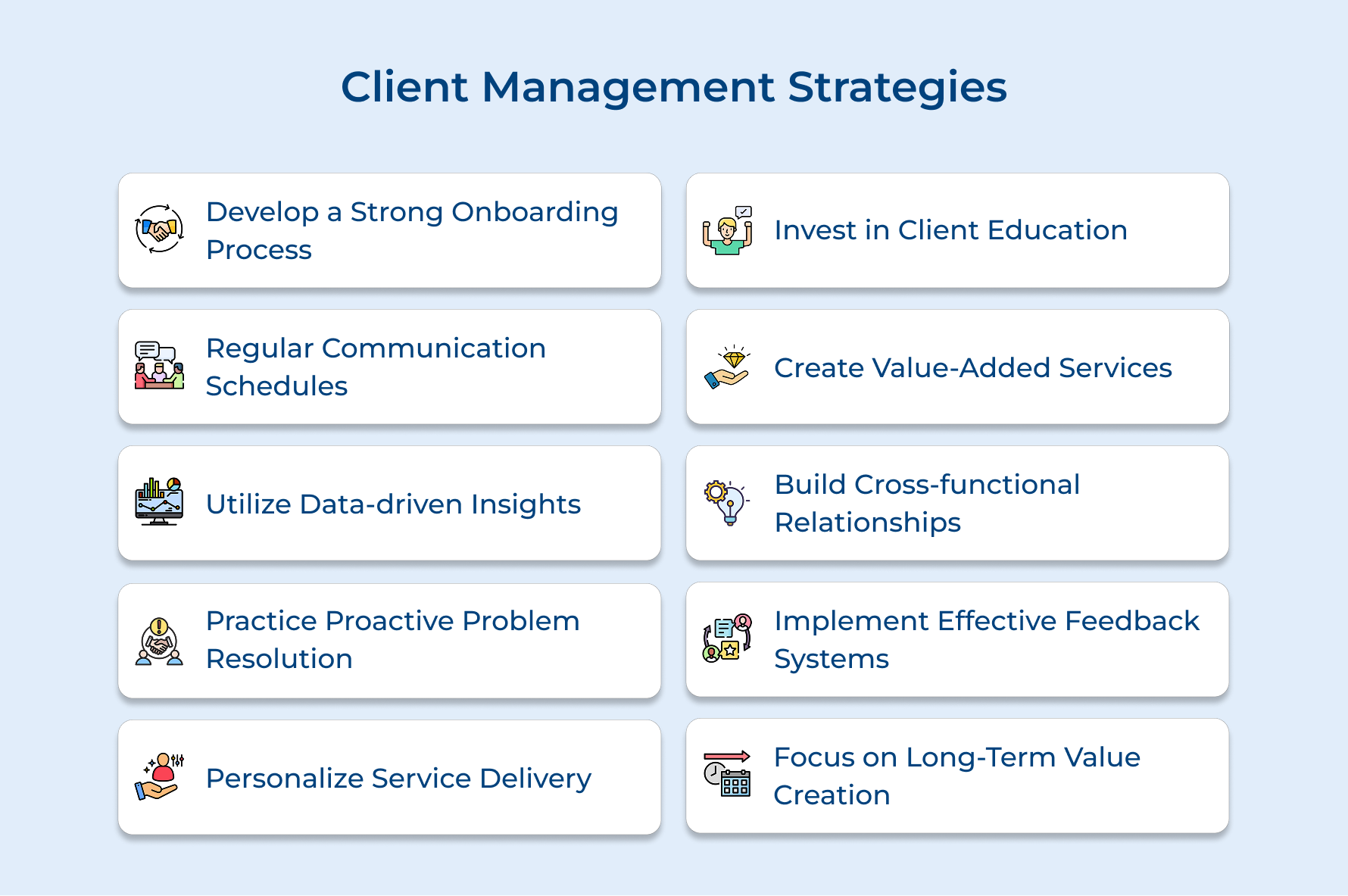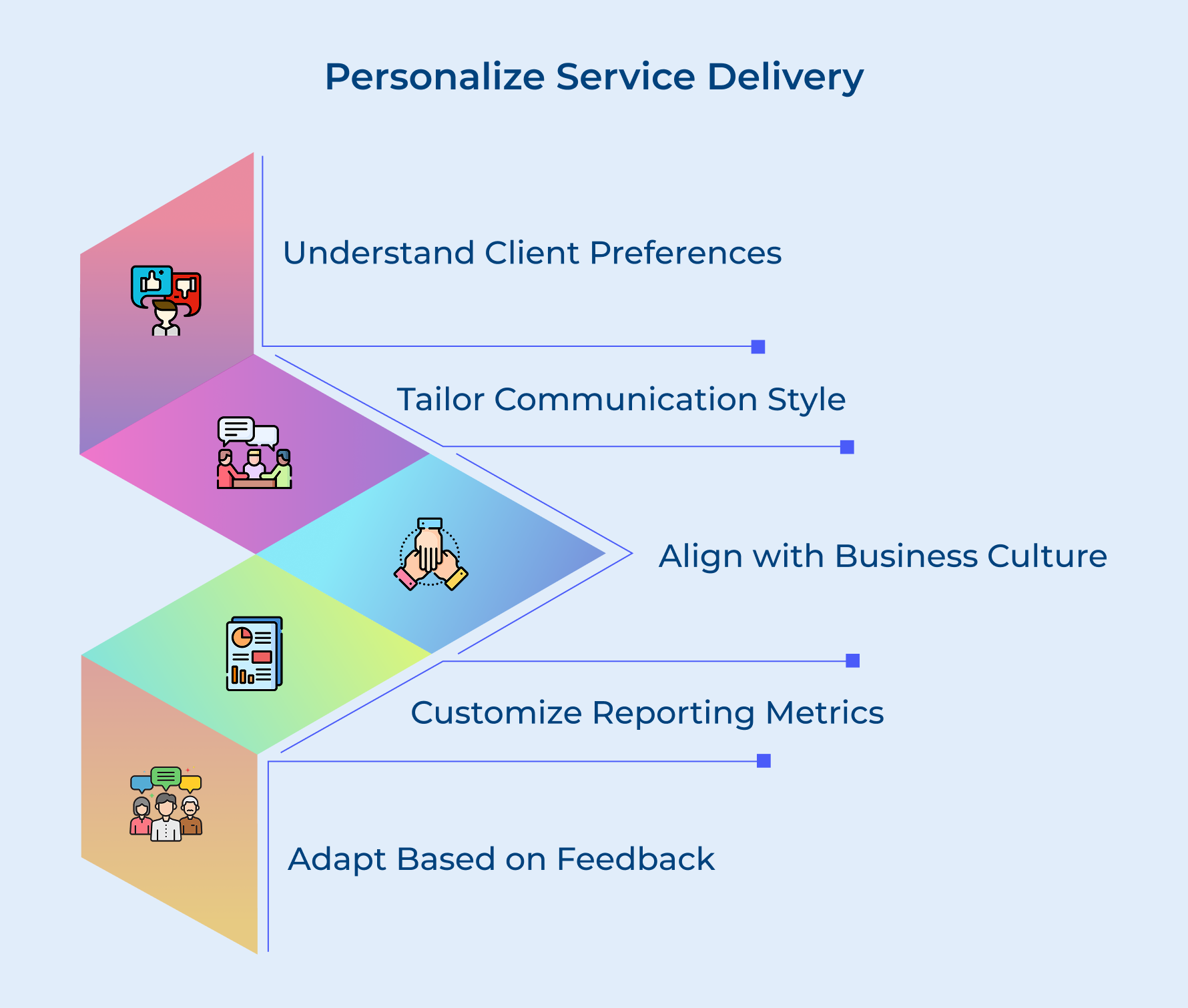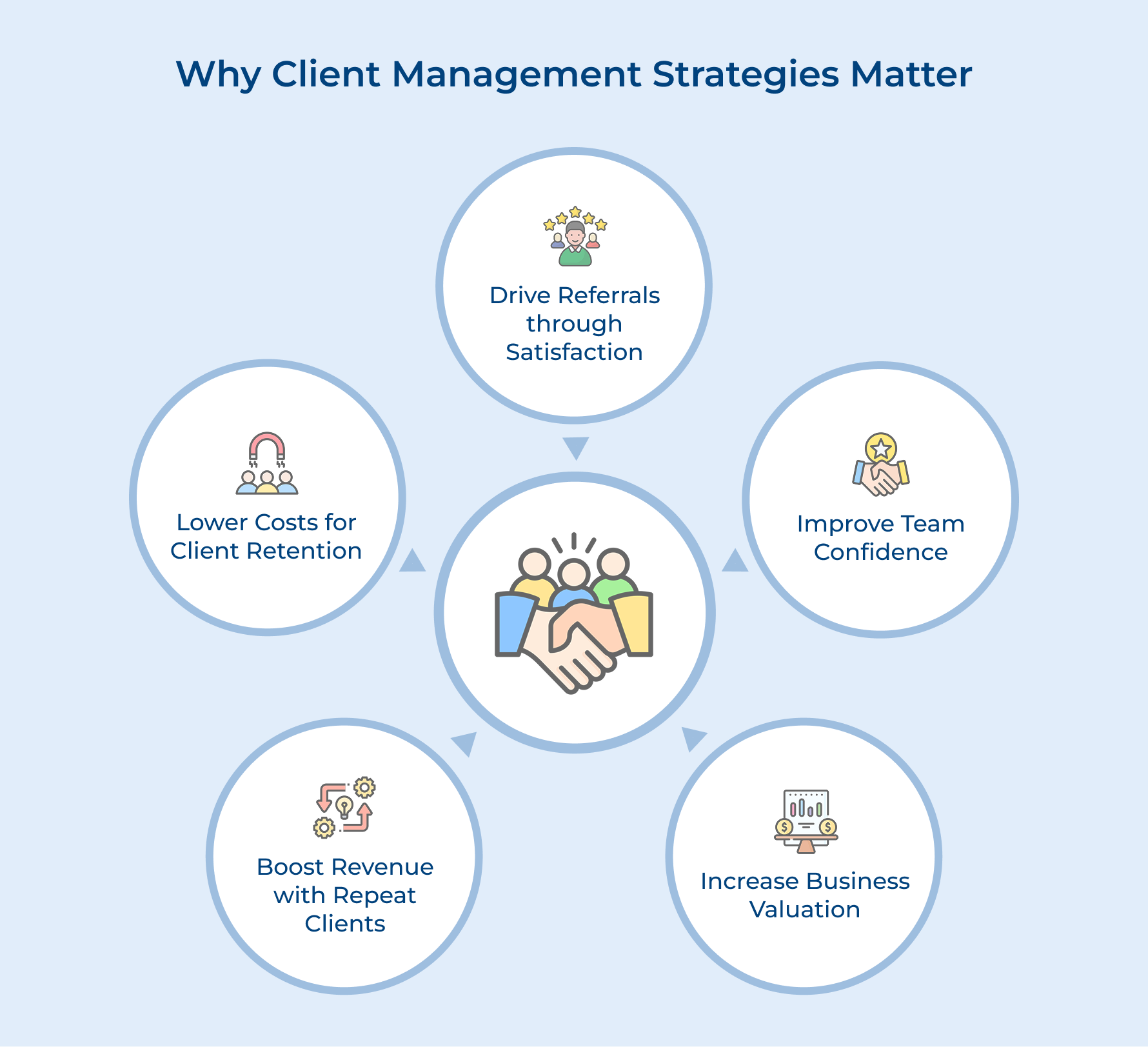10 Key Client Management Strategies for Maximizing Success

Key Highlights:
- Strong relationships lead to higher client retention, increased revenue, and sustainable business growth by consistently delivering value.
- Effective client management strategies reduce churn, enhance brand reputation, and create long-term partnerships.
- Proactive communication, data-driven insights, and value-added services strengthen client trust, ensuring mutually beneficial collaborations.
As businesses grow, maintaining strong client relationships becomes challenging. Without effective customer relationship management, businesses risk losing loyal customers, missing valuable referrals, and struggling to build lasting partnerships.
When client expectations aren’t met, retention drops, leading to higher churn and fewer repeat purchases. What’s the possible solution, you ask? Personalized service, clear communication, and consistent follow-ups. The client management strategies strengthen connections, enhance client satisfaction, and drive long-term success.
In this blog, we’ll show you how to master client relationship management and exceed expectations for lasting business growth.
What are Client Management Strategies?
Client management strategies are a set of approaches that businesses use to manage relationships with clients, ensuring their needs are met while building long-term partnerships. These strategies involve proactive communication, personalized service, and regular follow-ups to create an experience that keeps clients happy as well as engaged.
A well-executed client management strategy helps companies understand their clients’ needs and preferences, making it easier to tailor products or services accordingly. It also plays a key role in resolving issues promptly while maintaining a positive reputation, ensuring that clients feel valued.
Key objectives:
- Enhancing client satisfaction: Ensuring that clients consistently have a positive experience with your products or services.
- Building long-term relationships: Develop trust and loyalty with clients, turning one-time customers into repeat clients.
- Improving communication: Establishing open, transparent, and effective lines of communication to address client concerns as well as needs quickly.
Mastering Client Management: 10 Key Strategies for Success
Building strong client relationships is the key to business success. Explore 10 proven strategies to exceed expectations and boost retention.
1. Develop a Strong Onboarding Process
Bringing in a new client? A smooth onboarding process is key to setting clear expectations and building trust from day one. Here’s how to do it right:
- Welcome package – Start with a digital welcome package containing key info, contact details, and a quick-start guide.
- Kickoff call – Walk clients through your process, address questions, and align on goals.
- 30-60-90 day plan – Define milestones, check-ins, and early wins for a smooth transition.
- Personalized approach – Document client preferences to tailor their experience.
2. Regular Communication Schedules
Regular communication is key to building trust and avoiding misunderstandings. For example, imagine you’ve just started a project with a new client. To keep them in the loop, you set up weekly check-ins via video calls and email updates. These touchpoints allow you to discuss progress, address concerns, and adjust plans if needed.
A mix of formal and informal communication is essential. You might schedule a formal review every month, but a casual check-in every week via email keeps the relationship dynamic.
Pro tip: Use a project management tool to streamline updates, and always share your communication schedule upfront!
3. Utilize Data-Driven Insights
Understanding your clients through data is crucial for strengthening business relationships and ensuring satisfaction. How do we go about it?
- Track customer interactions: Use CRM systems to log client communications, preferences, and touchpoints. It helps you stay informed about their needs and history.
- Measure customer satisfaction: Regularly analyze satisfaction metrics and feedback to gauge how well you’re meeting client expectations.
- Anticipate client needs: Data insights help you predict what clients may need, allowing you to offer solutions proactively.
Tip to consider: Set up monthly data review sessions with your team to assess metrics and adjust your approach to enhance the relationship.
4. Practice Proactive Problem Resolution
Taking a proactive approach helps you stay ahead and maintain client satisfaction. Go the extra mile by:
- Anticipating potential issues: Regularly monitor projects and client feedback to identify challenges before they arise.
- Setting realistic expectations: Have open conversations with clients about potential risks and set clear, achievable goals.
- Creating contingency plans: Prepare solutions for common issues so you’re ready to act fast when necessary.
Actionable tip: Hold weekly internal reviews to address potential problems early and maintain open communication with clients to ensure they feel supported.
5. Personalize Service Delivery
Personalizing your approach can make a huge difference in client satisfaction. Think about it—when you understand what a client needs and how they work, you can tailor your service to match their unique style.
For example, when onboarding a client, take note of their communication preferences—do they prefer emails, calls, or video chats? What are their main goals, and what’s their business culture like?
How can you make your interactions with clients more effective? By regularly updating this info and adjusting based on their feedback, you’ll keep things running smoothly as well as build a lasting relationship.
Useful tip: Create customized reports that align with each client’s KPIs so they feel like you’re focused on their success.
6. Invest in Client Education
Educating your clients is one of the most powerful ways to build an effective client relationship management strategy. When you share valuable insights and resources, clients not only make informed decisions but also see you as a trusted advisor, not just a service provider.
How can you help your clients understand the bigger picture? Share monthly newsletters or create tailored resources that address their specific needs—this keeps them engaged and informed.
Helpful tip: Regularly update your clients on new trends or best practices through different channels like workshops and webinars to nurture long-term partnerships.
7. Create Value-Added Services
Offering more than just your core services can significantly enhance the client experience and set you apart from competitors. Think about providing exclusive content, priority support, or specialized tools to boost client satisfaction.
Here are some actionable tips to implement value-added services:
- Identify client pain points: Take note of where your clients may need extra help or additional services. Could a tool or extra support make their job easier?
- Develop complementary offerings: Create services that align with your core offerings but go a step further to solve client challenges.
- Use client feedback: Regularly survey clients (every 6 months or so) to uncover areas where they feel additional support could make a difference.
- Create tiered service models: Offering exclusive perks and specialized support for higher-tier clients will not only improve relationships but also incentivize loyalty.
8. Build Cross-Functional Relationships
Rather than relying on just one point of contact, aim to connect with multiple stakeholders across different departments within your client’s organization. It creates stronger, more resilient partnerships and gives you a better understanding of client needs from all angles.
Here’s how to make it happen:
- Map key stakeholders: Identify the key people in different departments and understand their roles as well as priorities.
- Engage across levels: Look for opportunities to involve stakeholders from various teams to ensure alignment and foster better collaboration.
- Host regular multi-stakeholder meetings: Set up meetings that involve representatives from different departments to discuss goals and challenges.
Actionable tip: Create a stakeholder map for each client and plan quarterly engagement activities with different departments to deepen relationships across the board.
9. Implement Effective Feedback Systems
Gathering client feedback is key to maintaining strong, effective relationships. A great way to do this is by using a mix of methods, like formal surveys, casual conversations, and regular review meetings.
Let’s say you regularly check in with a client through informal chats, and every quarter, you hold a more structured review session to discuss satisfaction along with areas for improvement.
This approach helps you catch any issues early and shows clients you’re committed to their success. The feedback you receive can guide you in refining your services while making necessary adjustments to exceed client expectations.
Tip: Set up a feedback tracking system to monitor trends and ensure every client suggestion is acted upon.
10. Focus on Long-Term Value Creation
Focusing on long-term value rather than quick wins is crucial for building lasting client relationships.
For example, think of a client whose business is growing rapidly, and instead of just meeting their immediate needs, you work with them to align your services with their long-term goals.
Having regular check-ins to assess progress and adapt to changes shows them that you’re invested in their success over the long haul. It not only strengthens the partnership but also opens up opportunities for continuous growth.
Pro tip: Set up annual strategy plans with your clients to outline long-term goals and schedule bi-annual sessions to adjust the plan as needed.
Why Client Management Strategies are Important?
Effective client management is key to business success, driving revenue growth, and enhancing operational efficiency. Let’s explore how strong strategies can lead to long-term value.
Revenue Stability and Growth
Strong client management ensures consistent revenue streams through repeat business. Satisfied clients not only return but often expand their engagement. Increasing customer retention by just 5% can boost profits by up to 95%.
Cost-Effective Business Operations
Retaining existing clients is far cheaper than acquiring new ones. Client management strategies help minimize churn, reducing the need for constant client acquisition efforts. This efficiency allows businesses to allocate resources more strategically.
Brand Reputation and Referrals
Satisfied clients become powerful brand advocates, offering testimonials and referrals that carry more weight than traditional advertising. These word-of-mouth recommendations lead to high-quality leads and easier client acquisition.
Employee Satisfaction
Clear client management strategies provide structure and purpose for client-facing teams. When employees understand how to manage client relationships effectively, they feel more confident and satisfied in their roles, leading to better service as well as lower staff turnover.
Long-Term Business Value
Companies with strong client management strategies are typically valued higher. The stability and predictability of client relationships make these businesses more attractive to investors as well as potential acquirers.
Effective Client Management for Business Longevity
Effective client management strategies are key to cultivating long-lasting relationships with customers. Focusing on personalized communication, timely follow-ups, and exceptional service helps businesses build trust as well as loyalty.
Prioritizing client satisfaction leads to repeat business and valuable referrals. Implementing these strategies will not only retain clients but also foster growth and sustainability. Strong, enduring partnerships are the foundation for long-term success, ensuring your business thrives and stays competitive in the marketplace.
Limit time — not creativity
Everything you need for customer support, marketing & sales.
Neeti Singh is a passionate content writer at Kooper, where he transforms complex concepts into clear, engaging and actionable content. With a keen eye for detail and a love for technology, Tushar Joshi crafts blog posts, guides and articles that help readers navigate the fast-evolving world of software solutions.


